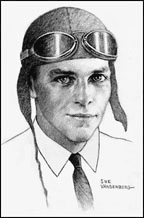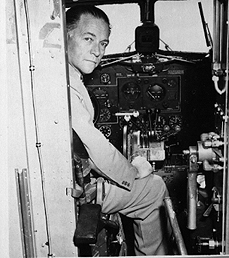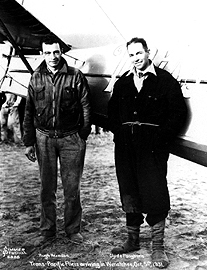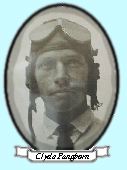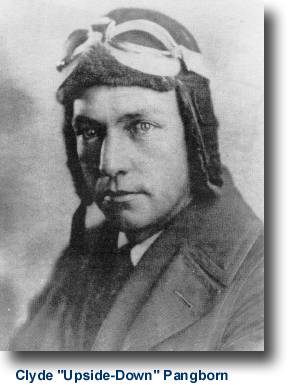Courtesy of the National Aviation Hall of Fame:
Clyde Pangborn
In 1919 Pangborn was an instructor at Ellington Field in Texas when the Commanding Officer offered him and his friend, Lieutenant Ralph Reid, their own plane while at the field. All they had to do was patch and repair the old Jenny. Since straightaway flying is boring they thought up things to do like diving on barnyards to watch horses jump over fences and cows kick over milk pails. They tried to take the knob from the community flagpole and the hands from the town hall clock. To keep from getting caught they used washable paint to disguise the plane’s numbers changing it from 314 to 841, 341 or 344.
In 1917 he volunteered for the Aviation Section of the Army Signal Corps and had an outstanding record during World War I.
After the war, he and Ivan Gates formed the famous Gates Flying Circus. Known as “Upside-down” because of slowly rolling airplanes onto their backs and gliding upside-down. During the Depression, he and Hugh Herdon, Jr. set out to fly from Japan to the U.S. Despite being arrested in Japan, mishaps and freezing temperatures the two landed safely in Wenatchee, Washington. He and Herdon received the Aviation League’s Harmon Trophy in 1931 for this venture.
During World War II helped establish the Ferry Command of the Royal Air Force. He also flew bombers to Hawaii and Australia.
Biography
1894-1958
Enshrined 1995
Clyde Edward “Upside Down” Pangborn was born in Bridgeport, Washington, on October 28, 1894. His family moved to Idaho in 1896, and after finishing high school, Pangborn attended the University of Idaho for two and a half years, where he studied civil engineering.
In 1917, Pangborn answered a call for volunteers and enlisted in the Aviation Section of the United States Army Signal Corps as a cadet and learned to fly. His performance was excellent and he eventually received a reserve commission as a Second Lieutenant and pilot in the Army Air Service in late 1918. After working temporarily as a flight instructor on Curtiss JN-4 ,”Jenny”, aircraft at Ellington Field in Houston, Texas, he was demobilized in March of 1919.
Pangborn, still interested in an aviation career, decided to pursue professional barnstorming – he made his living doing exhibition flying and aerial acrobatics at fairs, dedications and other public events throughout the West Coast region. He was known as “Upside-Down Pangborn” because of his penchant for slow-rolling planes onto their backs and gliding upside-down. In 1921, Pangborn and partner Ivan R. Gates formed the famous Gates Flying Circus, which performed both throughout the country as well as internationally. The show was very popular and successful. Over the course of six years, between 1922 and 1928, Pangborn flew approximately 125,000 miles without personal injury; he also held the world record for changing planes in mid-air. It was during this time that he had the fortunate occasion to meet pilot Hugh Herndon, Jr., who would later accompany Pangborn on their famous transpacific flight.
The heyday of barnstorming came to an end with the onset of the Great Depression, and the race to perform record flights swept the globe. Pangborn became determined to set one of those records. He and Hugh Herndon, Jr. first attempted to beat the around-the-world record set in 1931 by Wiley Post and Harold Gafty, but they were forced to abandon the endeavor in Russia. After this failure, the pair decided to fly from Japan to the United States, crossing the Pacific Ocean; however, the two pilots ran into some difficulty on their way to Tokyo, where they were to begin their mission. They were arrested, charged with flying over forbidden territory and taking illegal pictures of Japanese military fortifications, and were subsequently tried as spies and fined approximately $1,000 a piece. Despite this fiasco, Pangborn and Herndon, Jr. persuaded Japanese officials to grant them a permit to continue with their intended flight.
Pangborn and Herndon, Jr. finally took off from Samishiro Beach on October 4, 1931, in their attempt to win a $25,000 reward from the Japanese for a nonstop transpacific flight. They embarked in a reliable Bellanca monoplane called the “Miss Veedol,” with Pangborn acting as chief pilot and navigator and Herndon, Jr. as relief pilot and assistant navigator. During the flight, Pangborn was forced to perform a mind-boggling act of bravery and daring. When he dropped the landing gear of the Bellanca, two landing gear struts did not come loose. Using the experience he had gained during his barnstorming days, Pangborn had to walk out onto the wing strut of the Bellanca and free the two landing gear struts that had not disengaged. He did this, barefoot, in spite of hundred-mile-an-hour winds and the cold ocean below. It was truly an amazing feat of courage.
Despite the fact that they had taken little to no safety precautions, the two men landed safely in Wenatchee, Washington, their hands and feet numb but overall in good health and spirits. Their landing was quite a spectacle – not only did they miss their intended destination of Seattle, they also landed the plane without wheels! They had flown approximately 4,500 nonstop miles in 41 hours and 13 minutes, and they received the Japanese award money. Pangborn also received the Harmon Aviation Trophy for his achievement. For this monumental feat, he has since been honored with monuments both at Samishiro Beach and at the airfield in Wenatchee, now called Pangborn Field. As a result of this accomplishment, not only was an aviation record set, but an important Japanese-American cultural connection was also forged.
The transpacific flight was followed by Clyde Pangborn’s participation in the MacRobertson International Air Race in 1934, in which he flew with Colonel Roscoe Turner from London to Melbourne, Australia in a Boeing transport monoplane (the 247D). Pangborn and Turner came in second after a series of mishaps and delays, but their close finish was nonetheless a significant achievement.
During the years before the Second World War, Pangborn was employed by the Burnelli Company, where he demonstrated airplanes and promoted European interests in the company. He also became chief test pilot for the Bellanca Aircraft Corporation. Upon the outbreak of World War II, however, he dutifully offered his services and dedication to the Allied war effort, helping to establish the Ferry Command of the Royal Air Force and, as Senior Captain, participating in more than 175 ocean deliveries of military aircraft. During this time, Pangborn flew aluminum and other materials for British planes across the Atlantic, ferried American bombers to Hawaii and Australia for transfer to British pilots, and flew British Lancasters to North America for demonstrations in both Canada and the United States.
Besides his significant contributions during World War II, Pangborn was also the recipient of numerous awards and honors. These include the Harmon Trophy; the King’s Medal, which he received in England; and the White Medal of Merit, which he received in Japan. Shortly before his death, he was also selected to receive the Admiral William A. Moffett Maritime Aviation Trophy. Clyde Pangborn passed away in New York City at the age of 63, on March 29, 1958, and was buried with military honors at Arlington National Cemetery.
Courtesy of Washington State University:
Clyde Edward Pangborn, son of Max Pangborn and Opal Lamb Pangborn, was born in Bridgeport, Washington, on October 28th, 1896. His parents ranched on the upper Columbia River, but at the age of two they separated and Clyde remained with his mother. He grew up in the lumber camps of Idaho and graduated from St. Maries High School in 1914. He continued his education with extension courses in civil engineering from the University of Idaho; this training allowed him to secure a position as assistant to the Chief Engineer with the Bunker Hill and Sullivan Mining Company. America’s entry into the First World War afforded Clyde the opportunity to fulfill his lifelong desire to learn to fly. He enlisted in the Aviation Section of the Signal Corps and was trained as a pilot. Rather than being sent overseas after completing his advanced flight training, Pangborn was assigned to Ellington Field in Houston, Texas, as an instructor. After his discharge from the Army Air Corps, he returned to the Pacific Northwest and performed exhibition flying for Northwest Air craft Corporation based in Spokane, Washington. It was during this period that Pangborn made his ill-fated “automobile-to-airplane” transfer at Coronado Beach, California. His injuries in falling from the speeding car constituted the only serious accident in all his barnstorming career.
In 1921, Pangborn joined Ivan R. Gates as a partner in the formation of the Gates Flying Circus. For the next nine years Pangborn “barnstormed” across the en tire United States during which time he carried approximately 500,000 passengers without mishap or injury. Although half owner, Pangborn served as chief pilot and operating manager. Performing in an air show over Houston, Texas, in February 1924, Pangborn assisted in the mid-air rescue of a young stunt woman whose parachute had caught on the landing gear of Pangborn’s plane. This daring rescue, involving four aviators and two aircraft, as well as the hapless girl, catapulted the Flying Circus into national prominence. The Circus prospered during the later 1920s reaching its zenith with eleven planes at New Jersey’s Teterboro Air Show in August 1927.
The heyday of the barnstormers was ending with the 1920s; mounting federal regulations governing all aspects of flying were taking their toll. It was increasingly difficult to keep the wooden World War I vintage aircraft flying by the end of the decade and a new generation of machines, not as suited to circus performance, was appearing to challenge the wooden “crates” and their supremacy over the cities of America. Under this combination of pressures, the Gates Flying Circus quietly ended in Florida in the spring of 1929 after a tour of the Southeast.
Panghorn, however, retained his faith in the popularity and profitability of barnstorming. As chief test pilot for the New Standard Aircraft Corporation, which he, Gates and Charles H. Day formed in 1929, he had the opportunity to both fly and sell his own company’s product–barnstorming, in a manner of speaking. The stock market crash of 1929 wiped out the fledgling company; in its short history it had failed to make profit. Despite the company’s failure, Pangborn continued to believe in the financial feasibility of barnstorming and passenger carrying.
One of the pilots on the Western U. S. demonstration tour of the New Standard D-24 was Hugh Herndon, Jr., scion of a wealthy New York family. Herndon had purchased a D-24, learned to fly, and asked to be included in the Pangborn tour. After New Standard Aircraft folded, Pangborn and Herndon, whose mother put up her son’s half of the money, formed “The Flying Fleet” and began to tour the U. S. barnstorming and passenger carrying. Increased safety regulations and competition from the larger, single-wing, closed-cabin aircraft–“The Flying Fleet” continued to use the open cockpit New Standards–spelled the end of the Pangborn-Herndon air show. “The Flying Fleet” disbanded in February 1931 and the planes were stored in Palo Alto, California, the last city on the tour. Despite Pangborn’s vow to continue barn storming when the depression ended, the Fleet’s New Standards were later sold for hanger fees. In the short thirteen months of its existence, The Flying Fleet had carried 121,000 passengers and booked into nearly 100 cities in 36 states.
With his barnstorming days at an end, Pangborn looked for new projects. In conjunction with Herndon, he planned to break the around-the-world flight record of 20 days 4 hours set by the German Graf Zeppelin in 1929. The planning and preparation for this flight began in the spring of 1931 with the flight scheduled for the early summer. The two men formed an equal partnership–Herndon’s family supplying the money and Pangborn providing the expertise and flying skill necessary for such an undertaking. Pangborn chose a Bellanca “Skyrocket” as the perfect aircraft for its range, lifting abilities, and reliability. In late June, as their flight preparations neared completion, their hopes for an around-the-world record suffered a serious setback. In the last week of June, Wiley Post and Harold Gatty circumnavigated the globe in the time of 8 days 15 hours, 15 minutes. Using essentially the same route that Pangborn and Herndon had decided upon, Post and Gatty had lowered the record by over 11 days. Pangborn and Herndon now not only faced the challenge of making the flight, but more importantly of lowering the time of the Post-Gatty Lockheed monoplane. Determined to proceed, Pangborn reasoned that despite the Bellanca’s slower airspeed, its greater range (hence, fewer refueling stops) and rough field take-off ability would provide the necessary advantage in breaking the Post-Gatty record.
On July 28, after many weeks of preparation, the heavily-laden bright red Bellanca lumbered down New York’s Roosevelt Field No. 2, lifted off and headed out over the Atlantic on the first leg of the Around the-world flight. A few days earlier only Pangborn’s skill as a pilot averted a tragedy. In attempting to take off from the shorter Roosevelt Field No. 1, Pangborn was forced to dump part of the 830 gallons of fuel in order to get the plane airborne enough to clear a hangar at the end of the runway.
After crossing the Atlantic, Pangborn and Herndon landed in Wales. They flew on to London, Berlin, and Moscow. Upon leaving Moscow for Siberia, the two were almost ten hours behind the time of Gatty and Post. Further difficulties plagued them in Siberia. Herndon, at the controls while Pangborn slept, lost his way and they finally landed in a village in Mongolia. Back on course with more hours lost, they flew toward Khabarovsk, their last stop in Siberia. They landed in Khabarovsk in a blinding rainstorm; when the Bellanca touched down she settled deep into the mud of the runway. Forced to wait out the storm for a day and over 27 hours behind the Gatty-Post time, the two aviators considered their slower plane and decided to abandon the speed attempt.
With their hopes for an around the world speed record shattered, the duo then decided that they would try for the $25,000 prize offered by a Japanese newspaper, the Asahi Shimbun, for the first non-stop flight from Japan to the United States. After wiring their New York office to arrange the proper flight clearance and Japanese landing papers, the two took off for Tokyo, assuming that they had the necessary documents to land in Japan. Their flight from Khabarovsk took them over the northern Japanese island of Hokkaido. En route Herndon took photographs with both a still and 16mm movie camera. Upon landing in Tokyo, they were arrested for having no papers and for photographing naval installations in northern Japan. After considerable diplomatic wrangling, as well as several long sessions of intensive questioning by the police, Pangborn and Herndon were fined for their transgressions and released. After reluctantly giving the Americans permission to attempt the trans-Pacific flight, the Japanese officials informed Pangborn that only one take-off attempt was to be allowed. If the first try failed, or the flyers were forced to return after takeoff, the Bellanca would be impounded.
Several major obstacles faced the Americans if they were successfully to complete the first non-stop trans-Pacific flight. First, the Bellanca would be over loaded with fuel; consequently, they needed an extremely long runway from which to take off. They solved this problem by moving the plane approximately two hundred miles north of Tokyo to the 8,000 foot runway at Sabishiro Beach. Second, even with the extra fuel, Pangborn calculated that they might not have the range to complete the flight if they encountered anything but perfect flying conditions. There fore, he designed and constructed–without the knowledge of the Japanese–a mechanism which would enable the flyers to drop the Bellanca’s landing gear once it was airborne. This would effectively increase the airspeed by fifteen miles per hour or add approximately 600 miles to their range for the expected 40-hour flight.
Final preparations for the flight were completed by the first of October. Despite the loss of their maps and charts- reportedly stolen by a radical nationalist society which hoped to sabotage the flight–Pangborn was anxious to leave before the Japanese reconsidered their decision to allow the flight. After waiting several days for the weather to clear, the Americans began their historic flight on the morning of October 4th (Japanese time). The big Bellanca, burdened with 930 gallons of fuel and weighing in excess of 9,000 pounds–far beyond the manufacturers’ recommended or even tested specifications- reluctantly took to the air and headed out over the Pacific. Three hours into the flight, Pangborn dropped the wheels to reduce wind resistance; the wheels fell into the sea off the Japanese coast, but the landing gear struts did not release. Pangborn remedied this situation about halfway through the flight when he turned the controls over to Herndon and at 14,000 feet above the icy waters of the North Pacific, he crawled out onto the wing supports and freed the two landing gear struts. His experience as a wing walker in his early flying days had made the difference between a successful flight and a crash-landing; an attempted belly landing with the landing gear struts in place would have proved fatal.
Fighting the bitter cold in the late autumn skies over the Gulf of Alaska, the two fliers coaxed the “Miss Veedol” toward the U. S. mainland. Earlier there had been several large cash prizes offered for different versions of this record flight, but on nearing the U. S., Pangborn simply wanted to put down at a field where he could repair the landing gear and continue his around-the-world journey. With fog obscuring possible landing sites in Spokane and Pasco, the wings icing up, and fuel running low after about forty hours in the air; Pangborn decided to try for Wenatchee. He was familiar with the field; he knew that there would not be fog. With his mother and brother waiting on the ground in Wenatchee, Pangborn was assured of a welcome reception. At a few minutes after seven on the morning of October 5th, 1931, the big red Bellanca flew in low over the hills east of Wenatchee, make a quick pass over the field while Pang looked for obstacles, and finally settled down to a nearly perfect belly landing 41 hours and 15 minutes after taking off from Sabishiro Beach, Japan. Pangborn and Herndon had flown non stop almost 5,500 miles across the Pacific Ocean. Although it was a feat which equaled or exceeded the accomplishment of Charles A. Lindberg in his 1927 Atlantic crossing (a crossing which had been made many times before), neither public acclaim nor financial success materialized for Pangborn and Herndon. The Pacific was not flown non-stop again until after World War II. For his trans-Pacific flight Pangborn won the Aviation League’s Harmon Trophy symbolizing the greatest achievement in flight in the year 1931.
After landing in Wenatchee, the “Miss Veedol” was trucked to Seattle where the landing gear was rebuilt and refitted. Pangborn and Herndon then flew on to New York to complete their around-the-world flight. They had not established a new speed record, but they had been the first to cross the Pacific. As with the Gates Flying Circus and The Flying Fleet, the around-the-world flight proved to be a paradox for Pangborn. The Pacific crossing brought him recognition, but no commercial success.
The 1930s continued to be active years for Pangborn. In 1932 he piloted the first night air-express from New York to Los Angeles. The following year he demonstrated Fairchild Aircraft in Columbia, South America. In 1934 he joined with the flamboyant Colonel Roscoe Turner for the MacRobertson Air Race.
The MacRobertson Air Race–from London, England to Melbourne, Australia– was one of the premier air competitions in the world. Pangborn served as co pilot and navigator to the flashy Roscoe Turner. After a number of harrowing experiences during the almost 12,000-mile trip, Turner and Pangborn finished third. Only an overheating engine on the last leg of the flight prevented them from finishing second with their Boeing 247-D.
The MacRobertson Air Race proved to be Pangborn’s last major air competition as he moved into manufacturing and industry positions with various companies as a test pilot and design consultant. In 1935 he began an association with Burnelli Aircraft as a test and demonstration pilot which would survive into the post-World War II period. That same year, he also became the Chief Test Pilot for Bellanca Aircraft Corporation of New Castle, Delaware. In 1937 he demonstrated Burnelli Aircraft in England and Europe for Cunliffe Owen Aircraft Company of South Hampton, England. Pangborn remained with Cunliffe-Owen through the late 1930s where he tested military aircraft. When the war broke out in Europe in late 1939, Pangborn joined the Royal Air Force and assisted in organizing the R. A. F. Ferry Command. He recruited pilots throughout the United States and Canada for the Ferry Command and Eagle Squadron. From 1941 through the end of the war in 1945, Pangborn served as Senior Captain, Royal Air Force Ferry Command during which time he made approximately 170 trans-ocean flights (crossing both the Atlantic and the Pacific). In 1942 he brought the first Lancaster heavy bomber to the United States for tests and later returned with the same plane and demonstrated it to United States Army Air Force and major aircraft builders throughout the U. S. and Canada. During his tour with the Ferry Command, Pangborn flew almost every type of multi-engine air craft used during the war.
From the time of his discharge in early 1946 to his death in March 1958 Pangborn was intimately connected with flying, aircraft design, and testing. Throughout this period he ferried aircraft all over the world. In 1946 he made an airline route survey throughout Mexico for an American Mexican airline. He worked as a test pilot and engineer for Burnelli on the radically designed lifting body aircraft, and as a test pilot for Lear Aviation of Santa Monica, California. Pangborn was responsible for the original alterations on the Learstar which resulted in less drag. He also worked as a private pilot for a construction company.
During his forty-year aviation career Pangborn had flown to all parts of the civilized world without major damage to his aircraft. He held pilot’s license number 240 and was at the time of his death instrument-rated to fly single or multi-engine, land or sea planes. He had amassed more than 24,000 flying hours during his lifetime.
PANGBORN FUNERAL FRIDAY
NEW YORK, New York, April 2, 1958 – Clyde Pangborn will be buried with full military honors Friday morning at Arlington National Cemetery. The flier died here Saturday at the age of 63. Mrs. Pangborn’s body will be at the Frank E. Campbell funeral establishment, Madison Avenue and Eighty-First Street, today and tomorrow. A service will be held there at 8 P.M. tomorrow.
SERVICE HERE FOR PANGBORN
NEW YORK, New York, April 4, 1958 – About fifty persons attended a nonreligious service last night for Clyde Pangborn, early pilot who died Saturday at the age of 63. It was held at the Frank E. Campbell funeral establishment.
Mourners included Nancy Carroll, actress, and several pilots who were also friends or Mr. Pangborn: Bernt Balchen, Assan Jordanoff, Mrs. Eleanor Smith and Duke Krantz.
Burial in scheduled for today at Arlington National Cemetery
PANGBORN, CLYDE EDWARD
2LT US ARMY
- VETERAN SERVICE DATES: 05/11/1918 – 05/21/1919
- DATE OF BIRTH: 10/28/1894
- DATE OF DEATH: 03/29/1958
- DATE OF INTERMENT: 04/04/1958
- BURIED AT: SECTION 34 SITE 602-6
ARLINGTON NATIONAL CEMETERY
PANGBORN, CLYDE EDWARD
PFC 2ND LT DET OF FLYING CADETS ELLINGTON FLD TEX AIF SER U
- VETERAN SERVICE DATES: Unknown
- DATE OF BIRTH: 10/28/1894
- DATE OF DEATH: 03/29/1958
- DATE OF INTERMENT: 04/04/1958
- BURIED AT: SECTION 34 SITE 602-6
ARLINGTON NATIONAL CEMETERY
Michael Robert Patterson was born in Arlington and is the son of a former officer of the US Army. So it was no wonder that sooner or later his interests drew him to American history and especially to American military history. Many of his articles can be found on renowned portals like the New York Times, Washingtonpost or Wikipedia.
Reviewed by: Michael Howard

